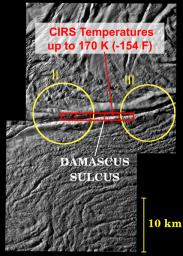This image shows the location of Cassini's most precise measurements so far of the surface temperatures at the active "tiger stripe" fractures that cut the south polar region of Enceladus. The background image, which shows the tiger stripe fracture named Damascus Sulcus, was obtained by Cassini's cameras during the close Enceladus flyby on August 11, 2008 (see PIA11113).
The yellow circles show the approximate location of two of the active plumes of ice particles identified by the Cassini cameras. The red rectangles show the region of Damascus Sulcus from which heat radiation was measured by Cassini's Composite Infrared Spectrometer (CIRS) at about the same time as the images were taken. The CIRS measurements indicate temperatures up to at least 170 Kelvin (-103 Centigrade or -154 Fahrenheit) near Damascus Sulcus. This is more than 100 degrees Kelvin (180 degrees Fahrenheit) warmer than the surrounding surface, due to heat escaping from Enceladus' interior along the fractures. However, even warmer temperatures are probable over smaller regions close to the tiger stripes, and temperatures are expected to be warmer still below Enceladus' surface. Therefore, subsurface temperatures may be high enough to melt ice to create liquid water, as is suggested by recent Cassini measurements of the salty composition of ice grains ejected from the tiger stripes.
The Cassini-Huygens mission is a cooperative project of NASA, the European Space Agency and the Italian Space Agency. The Jet Propulsion Laboratory, a division of the California Institute of Technology in Pasadena, manages the mission for NASA's Science Mission Directorate, Washington, D.C. The Cassini orbiter was designed, developed and assembled at JPL. The composite infrared spectrometer team is based at NASA's Goddard Space Flight Center, Greenbelt, Md.
For more information about the Cassini-Huygens mission visit http://saturn.jpl.nasa.gov/home/index.cfm. The composite infrared spectrometer team homepage is http://cirs.gsfc.nasa.gov/.

 Planetary Data System
Planetary Data System












